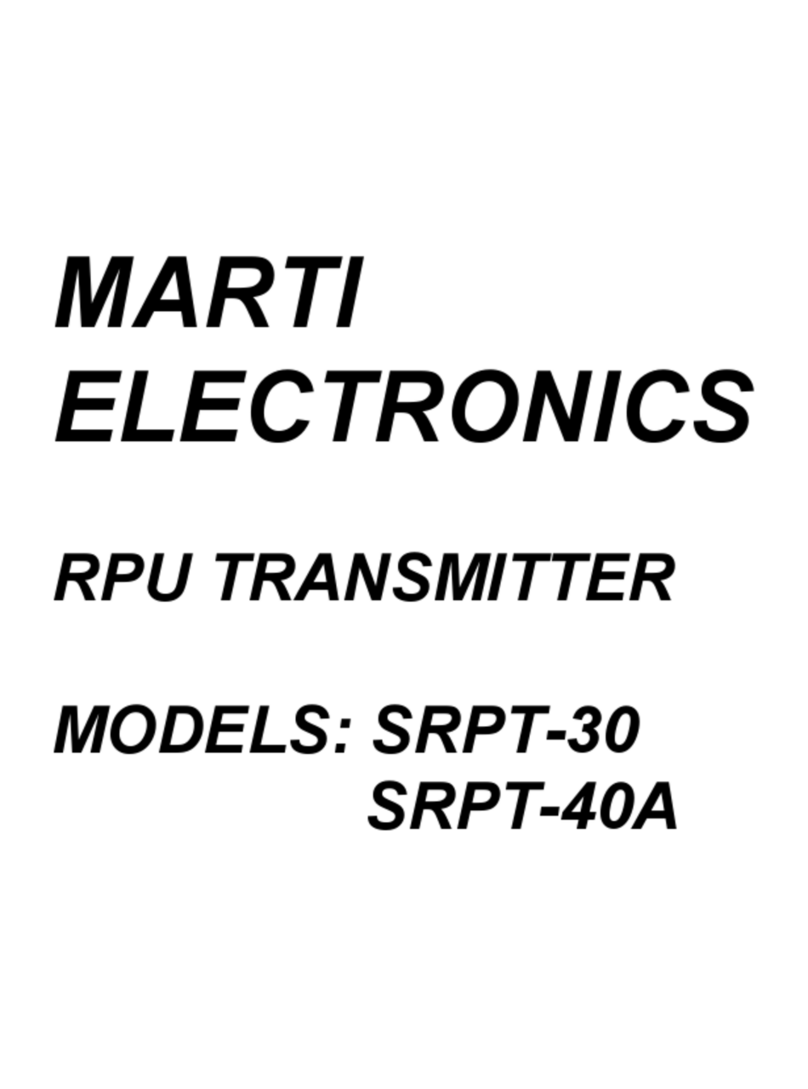
5
INSTALLATION
Install rack-mounted equipment in a well-ventilated, well-grounded, and shielded rack cabinet.
Do not locate solid-state equipment in a rack above tube-type equipment which produces high
temperatures. It is highly recommended that if the equipment is mounted in a rack cabinet, a blower
should be installed in the cabinet as well.
Problems can also be avoided by locating this unit away from other equipment which has
transformers that produce strong magnetic fields. These fields can induce hum and noise into the
Marti equipment thus reducing performance. Strong radio-frequency (RF) fields should be avoided
where possible. Extensive shielding and filtering have been incorporated into this equipment to permit
operation in moderate RF environments. All equipment racks, cabinets, etc., should be bonded
together by wide copper grounding strap to ensure that all system elements are at RF ground poten-
tial.
Stationary Remote Broadcast Installation
The basic stationary remote installation consists of the SRPT-40A transmitter, a 90-264 VAC power source, micro-
phones and other audio program sources, and a portable antenna. Remotes using portable antennas inside buildings have
very limited range (typically less than one mile). If greater range is needed, consider locating the transmitting antenna
outside the building at a height necessary to provide a line-of-sight path to the receiving antenna. This may not be
practical if a great length of coaxial cable is required. Many broadcasters are using the Marti mobile relay system to do
remotes from inside buildings. This system consists of the originating transmitter with its antenna inside the building
which transmits to a “mobile relay” parked outside the building. The mobile relay consists of a Marti Model AR-10 re-
ceiver and Marti RPT series transmitter with mobile antennas installed in a vehicle. The AR-10 receiver picks up the
encoded signal originating from the RPT series transmitter located inside the building, automatically turns on the relay
transmitter (on a different frequency), which re-transmits the program to the distant receiving antenna at the radio station
studio or transmitter site. (Mobile relay equipment packages are available from Marti.)
Stationary Remote Installation Procedure
1. The transmitter is normally located near the announcer or engineer to permit access to gain controls, microphone
inputs, the monitor jack, and metering.
Personnel must not be near the antenna when radiating. Locate antenna as far as possible from
people and equipment susceptible to RF radiation. Do not mount antenna directly on transmitter.
Refer to ANSI C95.1 “Limits on Non-Ionizing Radiation.”
2. With the SRPT-40A TRANSMIT/STANDBY switch in “STANDBY” position, plug the transmitter into a
grounded, three-prong, 90-264 volt, AC outlet.






























